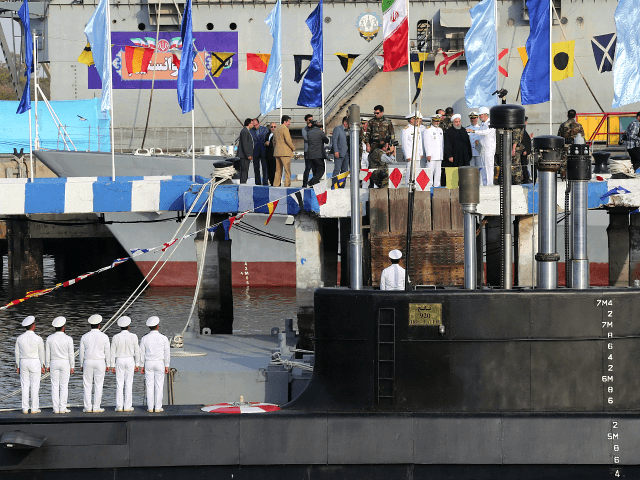|
Getting your Trinity Audio player ready...
|
Brazil will be welcoming a fleet of Iranian warships to Rio de Janeiro this week, Iranian state media announced, in what will be a first-ever visit by the rogue Iranian state’s navy to the Americas.
Iran’s state-run Fars News Agency reported last week that the 86th flotilla of the Iranian Navy would make an unprecedented pass through the Panama Canal to reach Rio de Janeiro and boasted its fleet is “equipped with anti-ship cruise missiles, torpedoes, and naval cannons” that allegedly “pose no threat” to other countries.
در کاخ رياستجمهوری و اولین مراسم عمومی پس از حوادث یکشنبه قبل، ناظر آغاز بکار #اولین وزیر
امور #بومیان #برزیل بودم.مردمان بومی و اجدادشان برای قرنهای متمادی در این خاک زیستهاند و انتظاراتی از نظام تحت سیطره مهاجران عمدتا اروپایی داشتهاند. دولت #لولا به این مطالبات توجه دارد pic.twitter.com/q5fepjDdsm— Hossein Gharibi (@gharibi14) January 12, 2023
Allowing Iranian warships to dock in Latin America is one of the first major decisions made by far-left radical President Luiz Inácio Lula da Silva in the foreign policy realm since taking office a month ago on February 1, beginning his third term in power after being sentenced on multiple appeals to over two decades in prison for corruption committed during his past time in office.
Lula won a hotly contested race against his predecessor, conservative Jair Bolsonaro, in October, prompting nationwide protests by Brazilians who rejected their supreme court, the Supreme Federal Tribunal (STF), choosing to exonerate Lula and allow him on the ballot. Lula defeated Bolsonaro running a dirty campaign in which he and his supporters spuriously accused Bolsonaro of atrocities such as pedophilia and cannibalism.
During his first two terms as president, from 2003 to 2011, Lula dedicated much of his foreign policy efforts to bolstering ties to Islamist Iran. Lula established warm ties to then-President Mahmoud Ahmadinejad – who had, in turn, focused on giving Iran a diplomatic stranglehold in repressive Iran and Venezuela – and supported Iran’s quest to develop a “peaceful” nuclear program, despite global concerns Iran would use any nuclear abilities to develop weapons to attack neighboring Israel.
The Argentine news network Infobae, citing Iranian media, reported on Wednesday that Iran’s war fleet would soon arrive in Brazil through the Panama Canal. The flotilla reportedly contains two of Iran’s most formidable warships: the Dena and the Makran.
“Dena is a Mowj-class warship that joined the Iranian Navy in June 2021. The military vessel is equipped with anti-ship cruise missiles, torpedoes and naval cannons,” Fars News explained in its report last week. “The other vessel of the flotilla is Makran, a forward base ship weighing 121,000 tons.”
The U.S. State Department responded to the arrival of Iranian warships in the Western Hemisphere with a statement expressing only that Washington was “aware” of the news.
“We are aware of these claims by Iran’s navy. We continue to monitor Iran’s attempts to have a military presence in the Western Hemisphere,” the State Department said in statements to Fox News and the Washington Free Beacon.
Iran has invested heavily in developing friendly ties to anti-American leftist regimes in Latin America, a region largely ignored by Washington foreign policy “experts” and heavily de-emphasized in importance under leftist President Joe Biden. In addition to this week’s naval display, Tehran has sent Foreign Minister Hossein Amirabdollahian to visit Nicaragua and Venezuela, flying out of allied Mauritania on Wednesday.
“The Iranian foreign minister is going to hold meetings with top officials in Managua and Caracas,” the pro-regime Tasnim News Agency reported on Wednesday.
Contrary to Biden, “Iranian President Ebrahim Raisi, who took office in August 2021, has described plans to promote cooperation with Latin American countries as a main pillar of the Islamic Republic’s foreign policy,” Tasnim noted.
Iran boasted of a delegation to Lula’s inauguration on January 1, consisting of Iran’s ambassador to Brasilia Hossein Gharibi and Vice-President for Parliamentary Affairs Mohammad Hosseini. The Tehran Times noted that Lula’s administration had reserved time for high-level meetings and a seat at the inauguration banquet for Hosseini.
Gharibi, the Iranian ambassador, appeared to welcome Lula’s return to power on social media with posts celebrating his alleged concern for Brazil’s indigenous community.
The Iranian embassy also invested heavily last week in Portuguese-language propaganda celebrating its slain terror mastermind Qassem Soleimani, eliminated by a drone strike ordered by President Donald Trump in 2020.
Lula’s foreign policy in his first two terms in office was largely defined by dragging Brazil out of the orbit of its traditional ally America and forging closer relationships with Iran, China, and Russia. Lula warmly welcomed Ahmadinejad to his country on a larger Latin America tour in 2009, insisting, “It is important that someone sits down with Iran, talks with Iran and tries to establish a balance so we can get back to a kind of normality in the Middle East.”
Lula also claimed to be a major participant in a nuclear fuel swap deal brokered alongside Turkey in 2010.
“Under the terms, Iran would send more than 2,600 pounds of low-enriched uranium to Turkey. In exchange, Iran would receive 265 pounds of uranium fuel rods for use in a research reactor,” journalist Judy Woodruff explained in a report at the time.
“Iran should have nuclear activities for peaceful purposes,” Lula’s then-Foreign Minister Celso Amorim asserted that year. “There is no political consensus that Iran has to be isolated or for Brazil to move in that direction.”
Follow Frances Martel on Facebook and Twitter.





